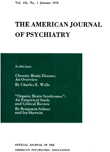PSYCHIATRIC ORIENTATION AND ITS RELATION TO DIAGNOSIS AND TREATMENT IN A MENTAL HOSPITAL
Abstract
These findings provide concrete statistical affirmation for the view that despite protestations that their point of reference is always the individual patient, clinicians in fact may be so committed to a particular psychiatric school of thought, that the patient's diagnosis and treatment is largely predetermined. Clinicians, as indicated by these data, may be selectively perceiving and emphasizing only those characteristics and attributes of their patients which are relevant to their own preconceived system of thought. As a consequence, they may be overlooking other patient characteristics which would be considered crucial by colleagues who are otherwise committed. This makes it possible for one psychiatrist to diagnose nearly all of his patients as schizophrenic while an equally competent clinician diagnoses a comparable group of patients as psychoneurotic.
It is important to note, however, that these differences in diagnosis occur primarily with respect to cases not clearly or easily traceable to organic causes (i. e., schizophrenia, psychoneurosis and character disorders). This obviously suggests greater opportunities for divergent points of view because of the lack of those objective criteria usually associated with diseases precipitated by some type of organic impairment. Whereas the latter can be more readily discerned with the aid of relatively reliable technical instruments (e. g., EEG), schizophrenia, psychoneurosis and character disorders suffer the absence of such nosologic criteria. In addition, organically impaired patients usually exhibit behavioral patterns more clearly associated with organic malfunctioning whereas the more purely functional categories require more arbitrary and hence, less objective distinguishing criteria.
Schizophrenia is particularly exposed to an additional difficulty which makes it a less reliable diagnostic entity. This difficulty is linked directly to the differences in psychiatric orientations discussed above and is relevant specifically to the psychoanalytic point of view. It was discerned that the greater the commitment to an analytic orientation, the less the inclination toward diagnosing patients as schizophrenics. This pattern is traceable to two somewhat related factors intrinsically associated with the analytic position. On the one hand, these psychiatrists are less concerned with diagnosis per se; they tend to argue that a diagnosis places unwarranted restrictions upon a more "complete" exploration of whatever psychological mechanisms are at work or related, presumably, to a patient's illness. Secondly, is the more pronounced "liberal" philosophy espoused by this school of psychiatric thought which, seemingly, operates to create an inhibitory attitude toward "unnecessarily" and "unjustifiably" applying a label which seemingly has deleterious connotations and, therefore, apparrently undesirable consequences for the patient so diagnosed.
Under present conditions, therefore, both diagnosis and the related care and treatment procedures tend to become more or less an adjunct of psychiatric orientation whereas the treatment program should be consequent on the diagnosis and a function of it. The alternative to present psychiatric classification problems should not, as some have suggested, be the elimination of diagnostic categories and the de-emphasis of classification procedures, but quite the reverse. What is needed is (a) a reconsideration of the means of eliminating the obvious biases connected with commitment to schools of psychiatric thought as an obstacle to the development of a taxonomic system of diagnosis, (b) increasing attention to the development of a standard nomenclature and (c) most important, emphasis on the development of objective, measurable and verifiable criteria of classification based not on personal or parochial predilections but on behavioral and other objectively measurable manifestations. Until such time as these criteria are available, research on the incidence and prevalence of the various disorders and on their etiology, treatment, and prevention will continue to be hampered and impeded.
Access content
To read the fulltext, please use one of the options below to sign in or purchase access.- Personal login
- Institutional Login
- Sign in via OpenAthens
- Register for access
-
Please login/register if you wish to pair your device and check access availability.
Not a subscriber?
PsychiatryOnline subscription options offer access to the DSM-5 library, books, journals, CME, and patient resources. This all-in-one virtual library provides psychiatrists and mental health professionals with key resources for diagnosis, treatment, research, and professional development.
Need more help? PsychiatryOnline Customer Service may be reached by emailing [email protected] or by calling 800-368-5777 (in the U.S.) or 703-907-7322 (outside the U.S.).



